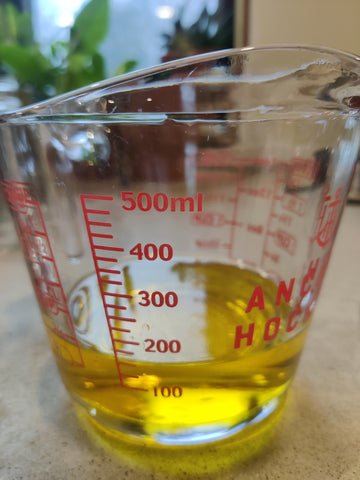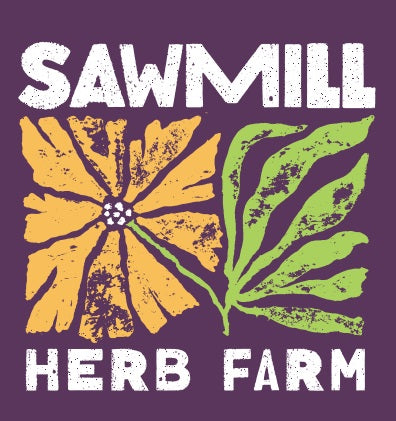Oils & Salves
OIL INFUSIONS
 Oil infusions are made from steeping (infusing) herbs, fresh or dried, into a carrier oil such as olive oil or jojoba oil. It’s a great way to use an herb topically for soothing and healing the skin. Oil is naturally absorbed through the skin and can act as a medium to carry herbal constituents deeper into the body. Herbal oils are the base of many other products like salves, lotions, creams and balms. It’s nice to have several oils on hand for making products all season long. I prefer making oils with freshly wilted herbs, like st johns wort, arnica and mullein flowers, or herbs I’ve dried myself like calendula blossoms.
Oil infusions are made from steeping (infusing) herbs, fresh or dried, into a carrier oil such as olive oil or jojoba oil. It’s a great way to use an herb topically for soothing and healing the skin. Oil is naturally absorbed through the skin and can act as a medium to carry herbal constituents deeper into the body. Herbal oils are the base of many other products like salves, lotions, creams and balms. It’s nice to have several oils on hand for making products all season long. I prefer making oils with freshly wilted herbs, like st johns wort, arnica and mullein flowers, or herbs I’ve dried myself like calendula blossoms. To make an oil infusion, I like to wilt my herbs for at least a day to remove some of the water content. Chop your fresh herbs into small pieces and loosely fill a jar. Cover the herbs with oil, with about an extra inch or so on top of the plant material. For a more technical method, use 1 part fresh plant by weight to 3 parts oil by volume. For dried herb infusions, use 1 part dry plant by weight to five parts oil by volume. If you need to add extra oil to cover that’s fine.
Using a fork push down all the material so its under the oil, otherwise it may mold. You can also use the fork to gently remove air bubbles, scrapping the sides of the jar. I loosely cover the jar with a lid or tightly woven muslin and set it out in the sun (or a warm sunny window – consistent temp of around 80 degrees is good) for about two weeks. Shake occasionally, and wipe off water from the lid if any forms.
To make an oil infusion, I like to wilt my herbs for at least a day to remove some of the water content. Chop your fresh herbs into small pieces and loosely fill a jar. Cover the herbs with oil, with about an extra inch or so on top of the plant material. For a more technical method, use 1 part fresh plant by weight to 3 parts oil by volume. For dried herb infusions, use 1 part dry plant by weight to five parts oil by volume. If you need to add extra oil to cover that’s fine.
Using a fork push down all the material so its under the oil, otherwise it may mold. You can also use the fork to gently remove air bubbles, scrapping the sides of the jar. I loosely cover the jar with a lid or tightly woven muslin and set it out in the sun (or a warm sunny window – consistent temp of around 80 degrees is good) for about two weeks. Shake occasionally, and wipe off water from the lid if any forms.If you see water precipitate forming on the bottom of the jar, you can use a turkey baster to draw it out or pour it off. Herbalist JJ Pursell recommends dumping the contents of the oil into a saucepan and gently heating for five minutes to evaporate the water before allowing it to continue steeping in the sun. When herbal oil grows mold, it is often because there is too much moisture present in the herb or in the jar. Try using dry herbs or wilting fresh herbs for a few days before you make oil.
Pursell also recommends using the oven method, particularly with dried herbs by placing your herbs in a glass baking pan and adding oil to cover by 1 or 2 inches. Turn the oven on low, 170 to 200 degrees F and baking for 4 to 6 hours. Make sure to keep an eye on it to make sure the oven doesn’t get too hot. And stir it occasionally.
After the herbs are done infusing, strain the oil into a glass jar using muslin or cheesecloth and label. Some oils, like olive oil tend to go rancid within a year, while others like jojoba oil are technically a wax and have a much longer shelf life. We have switched over to mostly using jojoba oil for our infusions for this reason.
A good book for medicine making is JJ Pursell’s "Master Recipes from the Herbal Apothecary."
SALVES
 Salves are made of beeswax, herbs and oil. The oil is a solvent for the medicinal properties of the herb while the beeswax provides necessary firmness, doesn’t clog pores and is nourishing. To make a simple salve, put one cup of your herbal-
infused oil into a pot and add 1/4 cup of beeswax. Heat gently over a double boiler until the beeswax is completely melted. To test for doneness, put a teaspoon of the mixture in the freezer for a minute. If it’s too soft, add more beeswax; too hard, add more oil. Remove from heat and pour into small glass jars. Store in a cool, dark place. Salves may last for months and possibly years.
Salves are made of beeswax, herbs and oil. The oil is a solvent for the medicinal properties of the herb while the beeswax provides necessary firmness, doesn’t clog pores and is nourishing. To make a simple salve, put one cup of your herbal-
infused oil into a pot and add 1/4 cup of beeswax. Heat gently over a double boiler until the beeswax is completely melted. To test for doneness, put a teaspoon of the mixture in the freezer for a minute. If it’s too soft, add more beeswax; too hard, add more oil. Remove from heat and pour into small glass jars. Store in a cool, dark place. Salves may last for months and possibly years. Salves are great for external healing for healthy skin and tissues. Consider making several different oils and combining them for a multi-purpose salve. You can experiment with adding shea or cocoa butter. Herbs to try making oils and salves out of it include: calendula (best dry), sage, yarrow, comfrey, st. john’s wort, nettle, lavender, chamomile, mint, mullein, witch hazel and plantain.
Salves are great for external healing for healthy skin and tissues. Consider making several different oils and combining them for a multi-purpose salve. You can experiment with adding shea or cocoa butter. Herbs to try making oils and salves out of it include: calendula (best dry), sage, yarrow, comfrey, st. john’s wort, nettle, lavender, chamomile, mint, mullein, witch hazel and plantain.

